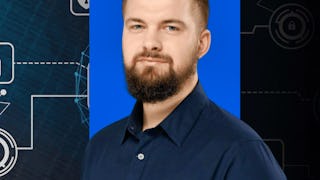The explosive growth of the “Internet of Things” is changing our world and the rapid drop in price for typical IoT components is allowing people to innovate new designs and products at home. In this first class in the specialization you will learn the importance of IoT in society, the current components of typical IoT devices and trends for the future. IoT design considerations, constraints and interfacing between the physical world and your device will also be covered. You will also learn how to make design trade-offs between hardware and software. We'll also cover key components of networking to ensure that students understand how to connect their device to the Internet. Please note that this course does not include discussion forums.



Introduction to the Internet of Things and Embedded Systems
This course is part of An Introduction to Programming the Internet of Things (IOT) Specialization

Instructor: Ian Harris
342,684 already enrolled
Included with 
(13,288 reviews)
Skills you'll gain
Details to know

Add to your LinkedIn profile
4 assignments
See how employees at top companies are mastering in-demand skills

Build your subject-matter expertise
- Learn new concepts from industry experts
- Gain a foundational understanding of a subject or tool
- Develop job-relevant skills with hands-on projects
- Earn a shareable career certificate


Earn a career certificate
Add this credential to your LinkedIn profile, resume, or CV
Share it on social media and in your performance review

There are 4 modules in this course
The Internet of Things (IoT) is a popular buzzword right now, but unlike many fads which have come and gone, the Internet of Things describes an important trend which is having lasting effects on society at large. The term itself, “Internet of Things”, is used to mean a variety of ideas, depending on the motivation and background of the speaker. This course will start by providing a definition of the term. We will talk about how various trends have enabled the Internet of Things, and how it changes the way design is performed. We will also discuss some of the ramifications that IoT is having on society today.
What's included
10 videos4 readings1 assignment1 peer review
In Module 1, we introduced the concept of the Internet of Things at a high level, defining the term and outlining its implications. In this module we explore some of the details involved in the design and implementation of IoT devices. Unlike traditional computer-based systems, IoT devices are “embedded” within other devices in order to provide enhanced functionality without exposing the user to the complexities of a computer. The users interact with the device in a natural way, similar to their interactions with any other objects in the world. In this way, an embedded system has an interface that conforms to the expectations and needs of the users. Establishing a natural interface requires that the embedded system interface with the physical world directly through sensors, which read the state of the world, and actuators, which change the state of the world. In this module we will discuss the structure of embedded systems and describe these interactions with the physical world.
What's included
9 videos2 readings1 assignment1 peer review
IoT devices are implemented using both hardware and software components. Dedicated hardware components are used to implement the interface with the physical world, and to perform tasks which are more computationally complex. Microcontrollers are used to execute software that interprets inputs and controls the system. This module discusses the roles of both the hardware and software components in the system. The functions of common hardware components are described and the interface between the software and hardware through the microcontroller is explained. IoT devices often use an operating system to support the interaction between the software and the microcontroller. We will define the role of an operating system in an IoT device and how an IoT operating system differs from a standard one.
What's included
9 videos2 readings1 assignment1 peer review
An important aspect of the Internet of Things is that devices are networked in some way, and often connected to the Internet. Networking enables devices to communicate with other IoT devices and larger cloud-based servers. IoT devices can often be thought of as small parts of a much larger collective system which includes large servers based in the cloud. This module will introduce the basics of networking and the Internet protocol in particular. Eventually, most IoT devices are connected to the Internet, so understanding the protocols associated with the Internet is important to the design of IoT devices. We will also introduce the concept of a Mobile Ad Hoc Network, or MANET, which describes small, local networks of IoT devices.
What's included
10 videos3 readings1 assignment1 peer review
Instructor

Offered by
Recommended if you're interested in Software Development


IIT Bombay


EIT Digital


Kennesaw State University
Why people choose Coursera for their career




Learner reviews
13,288 reviews
- 5 stars
74.29%
- 4 stars
21.54%
- 3 stars
2.73%
- 2 stars
0.66%
- 1 star
0.76%
Showing 3 of 13288
Reviewed on Sep 30, 2020
This is really a very good course for the people who want to understand the IoT & Cloud computing from basic to enhanced level. The practical approach of assignment of each area is fantastic.
Reviewed on Nov 26, 2017
Great class! Overall, it covers mostly the basics of Internet of Things. Good for those who are new to the field. Would not recommend it to those who have some knowledge on embedded systems already.
Reviewed on Nov 8, 2019
The course covers the basics of the Terms which are used in IoT systems and introduces you to some networking terms. Not a lot of hands-on stuff. Expecting a lot of stuff in the upcoming courses.
New to Software Development? Start here.

Open new doors with Coursera Plus
Unlimited access to 10,000+ world-class courses, hands-on projects, and job-ready certificate programs - all included in your subscription
Advance your career with an online degree
Earn a degree from world-class universities - 100% online
Join over 3,400 global companies that choose Coursera for Business
Upskill your employees to excel in the digital economy
Frequently asked questions
Access to lectures and assignments depends on your type of enrollment. If you take a course in audit mode, you will be able to see most course materials for free. To access graded assignments and to earn a Certificate, you will need to purchase the Certificate experience, during or after your audit. If you don't see the audit option:
The course may not offer an audit option. You can try a Free Trial instead, or apply for Financial Aid.
The course may offer 'Full Course, No Certificate' instead. This option lets you see all course materials, submit required assessments, and get a final grade. This also means that you will not be able to purchase a Certificate experience.
When you enroll in the course, you get access to all of the courses in the Specialization, and you earn a certificate when you complete the work. Your electronic Certificate will be added to your Accomplishments page - from there, you can print your Certificate or add it to your LinkedIn profile. If you only want to read and view the course content, you can audit the course for free.
If you subscribed, you get a 7-day free trial during which you can cancel at no penalty. After that, we don’t give refunds, but you can cancel your subscription at any time. See our full refund policy.
More questions
Financial aid available,



